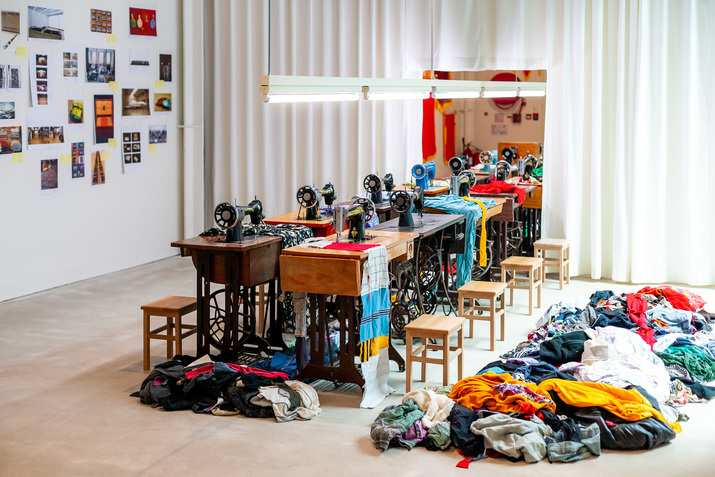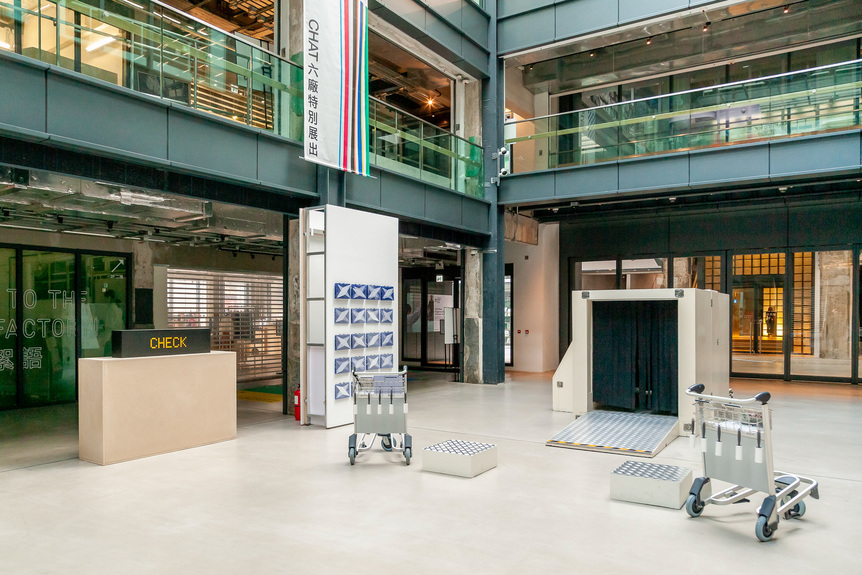
R
E
V N
E
X
T
Chinese artist Yin Xiuzhen has been collecting personal and collective memories through her textile-based installations, comprising used clothes, which reflect both her childhood and China’s recent rapid socioeconomic changes. Her large-scale installation Trojan (2016–17) shown at the 58th Venice Biennale in 2019 for example, depicting a female figure in the brace position on an airplane seat, references the country’s excessive consumerism and the devastations of a globalized economy. Her latest mid-career retrospective, “Sky Patch,” at Hong Kong’s Centre for Heritage, Arts and Textile (CHAT), formerly the textile factory Nan Fung Textiles, showcased her latest commissions as well as works from the past two decades. The exhibition, like some of her other works, was put together with the help of her family. Pamela Wong spoke with the artist about the role of textiles in her life, how her family, particularly the mother-daughter relationship, influences her works, and the impacts of China’s recent economic reforms.
What role does textiles play in your life? How did it become your main medium of creation?
I started used clothing during my first solo exhibition in 1995, at Beijing’s Central Academy of Fine Arts’ Affiliated High School of Fine Art. My first textile-based work, Dress Box (1995), is a wooden box holding a pile of carefully folded clothing, which were stitched together and sealed with cement inside the box. I photographed these clothes before they were sealed, and the photo series, My Clothes (1995), were exhibited with the box. There’s a copper plate on the box that reads, “These clothes are ones I’ve worn over the past three decades, which carry my experiences, your memory, and traces of time.” I began with collecting my own experiences, and over time, I gradually became interested in collecting the experiences of others.
I’m interested in clothing as a medium because it is deeply intertwined with my family’s story. My mother used to work at a textile factory. When I was young, people couldn’t just buy fabrics to make clothes. Because of China’s planned economy at the time, everything required stamps, from clothing to food. Therefore, it was very difficult to obtain new clothes, and I developed fond memories for each article of mine. Even now, when I look at other people’s old clothing, I can’t help but think, “Who wore these? Where have they been?” I think clothes carry a certain weight to them.
Installation view of YIN XIUZHEN’s My Clothes, 1995/2020, photo, set of 32, 53.3 × 80 cm each, at “Sky Patch,” Centre for Heritage, Arts and Textile (CHAT), Hong Kong, 2020–21. Courtesy CHAT.
You installed some untitled, triangular shaped red flags in Factory Floor (2020), a room-sized reproduction of a factory workshop, and across the walls of one of CHAT’s permanent galleries, which holds displays detailing the history of the former factory. These flags are similar to those used in mainland Chinese schools for rewarding excellence. What was your impetus for the arrangement?
When I was little, I visited my mother’s factory and saw how the workers were rewarded with these red flags. Of course, those flags had Chinese characters on them [usually names of the awardee and the institution], but I left my flags blank because I think this is more intriguing. Hanging these flags at CHAT creates a certain association with China’s era of economic expansion.
The reputation of Nan Fung Textiles in Hong Kong at that time corresponded to Beijing’s National Textile Cotton Mills, which were established in the ‘50s after the founding of People’s Republic of China and was one of the nation’s pillaring industries. My mother worked at National Textile Cotton Mill 3 and our family lived near Mill 2. Back then, it was an honor to have a family member working at those factories. Ever since the factory’s decline, however, it became part of the state-owned conglomerate Jingmian Co. Ltd.. Mill 2 became a creative park and Mill 3 became a fashion-oriented building. Similarly, Nan Fung Group transformed the space of its mills into an institution combining art and commerce, CHAT. For the video [Sky Patch (2020)], the company in charge of post-production is located in the building of the previous Mill 3. The connection of these two factories is the point of departure for this exhibition.
In Factory Floor, the wooden box placed on one of the working tables appear antique, but was actually created by your family. You also feature family members in your videos, and created your latest video, Sky Patch, with your husband, the artist Song Dong. How is creating art with your family like?
When my siblings and I were young, we loved Chinese New Year because my mother would make us new clothes, so I developed a special feeling towards the sewing machine. I would wait in front of the machine for her to finish making the new clothes. Her sewing machine was brought to Beijing by my father from Tianjin. He refurbished it and painted it, and made a wooden box, which my sister and I painted over with scenes from Dream of the Red Chamber (1791). We didn’t think at the time that painting the box is considered art. We thought we were only decorating it, because we both liked to draw. My sister grew up and eventually chose to work in another industry, and although we didn’t discuss much about art, she bought art books for me and sent me to art classes.
My mother also doesn’t understand art, but she helps me with handicrafts. For Dress Box, my mother was the first person to help me stitch the clothes together. Later on, for other series including Portable Cities (2001– ) [comprised of suitcases containing cloth made cityscapes], I sketched the designs and she helped me with the stitching. Eventually my whole immediate family started helping me. Even though they don’t necessarily understand what they are making, we sit together and chat, something that I feel embodies what kinship is.
How did your mother-daughter relationship influence your works, specifically, for the multi-channel video installation Rebel (2013–20), comprising clips of your daughter as she grew up, and Sky Patch, which follows your mother in her hometown?
It is only after I had a daughter that I developed a better understanding of the relationship between my mother and I. I thought I understood my daughter, until one day she said to me, “There’s a large generation gap between us.” Her reaction made me reconsider my relationship with my mother, who doesn’t understand my art. Sometimes I’m angry with my daughter for spending so much time on the computer, when she’s obviously playing games. She would argue that she’s studying. In the beginning, the videos were not so much about my daughter, but her proportion increased as I was creating the works, and as a result they occupied the whole gallery space, becoming Rebel. I guess it also reflects my concerns about her: her [potentials] are unknown, and she’s uncontrollable. I could only interact with her through the videos, which are fragmented, requiring the audience to stitch together. In the middle of the room there is a mannequin on top of a few shipping boxes, referring to my daughter’s childhood, when she would climb up and down the boxes in our studio.
For the video essay Sky Patch, I reflected on my mother’s past. It was another opportunity to bring her in—the first time in many years since I hired my assistants. She is now 80 years old, and she witnessed firsthand China’s changes during the 20th- and 21st-centuries. I tried to trace her footsteps back to her hometown Tianjin, while my daughter also makes an appearance. I included both their ages in the end credits, to create the impression of three generations. The title was inspired by the Chinese mythology of the goddess Nüwa patching up the sky. I think in every generation, there’s a sky waiting to be mended, and there are gaps to be filled between parents and children. The work serves as a bond that unifies myself, my daughter, and my mother.
How has Covid-19 and travel restrictions affected your exhibition plans for CHAT?
Fortunately, I visited CHAT before the pandemic, since we have been planning this exhibition for two to three years. I changed some of the works, however. For example, installation In Transit (2020), mounted in the building’s lobby, replaced another work from our original plan after I discovered that in some countries, people could purchase tickets to board airplanes that just hovered above their own cities for the experience of “flying.” I created this work in imitation of the airport’s transit zone, producing a gathering spot for visitors to the show to make up for their lack of travelling. For the actual exhibition space on the top floor, it was difficult to curate CHAT’s hallways, so I separated the corridors into different rooms. The mannequins [from Fashion Terrorism (2004– )] that I deliberately placed next to the glass windows resonate with the building’s commercial stores downstairs, which you can see through the glass.
Fashion Terrorism comprise mannequins wrapped in black and nude fabric in assorted styles, shown with photographs of these mannequins in poses imitating those used by fashion models with Shanghai as a backdrop. The series criticizes the side effects of China’s rapid urbanization and the nature of fast fashion. What are your thoughts on China’s economic growth given your interests in ecological concerns and deglobalization?
Before the pandemic, which created all the chaos this year [in 2020], the world was pursuing a globalized economy, and I feel like the world was a large machine, with each country acting as a small component responsible for running it. But now, for example, Huawei can’t produce their smart phones as the necessary chips have been controlled [by the United States], and even if China wants to develop its own technology for the chips, it will take time. China went through a rapid phase of economic development and expansion, especially after joining the World Trade Organization (WTO), but this also comes at a price, including the exploitation of resources and of the environment. I think it is not just China’s problem to face though, it’s a global issue. To me, 2020 seemed like a turning point, and nobody knows what would happen after the pandemic.
Pamela Wong is ArtAsiaPacific’s assistant editor.
Yin Xiuzhen’s “Sky Patch” is on view at Centre for Heritage, Arts and Textile (CHAT), Hong Kong, until February 28, 2021.
To read more of ArtAsiaPacific’s articles, visit our Digital Library.


















